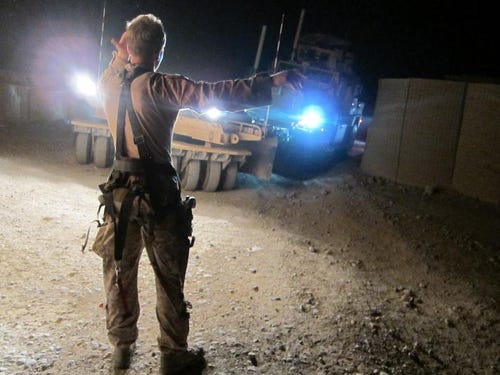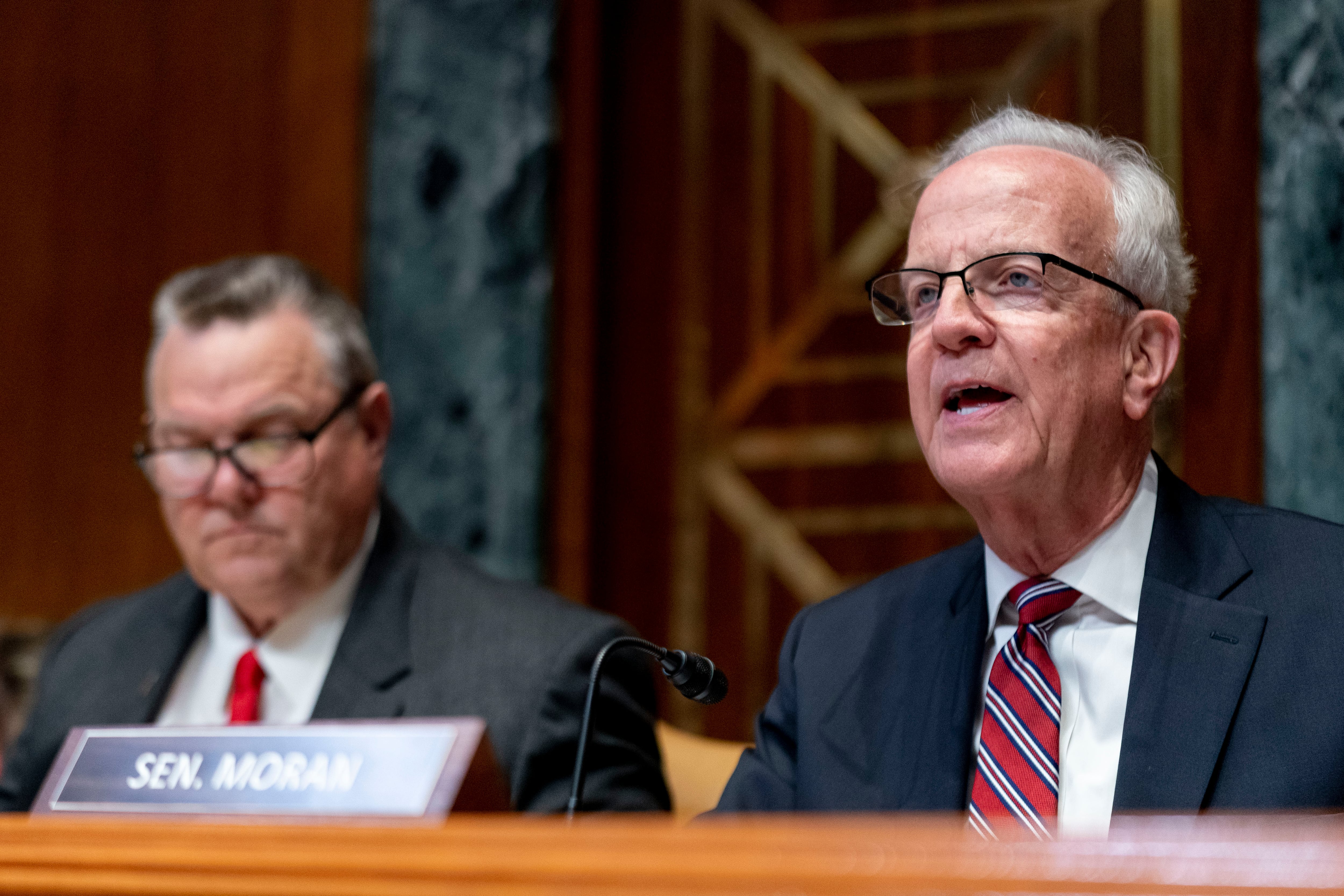source GAIA package: Sx_MilitaryTimes_M6201410305120018_5675.zip Origin key: Sx_MilitaryTimes_M6201410305120018 imported at Fri Jan 8 18:18:16 2016
 They had called it "Sangingrad."
They had called it "Sangingrad."
A full third of all British casualties in Afghanistan had occurred in the Sangin district of Helmand Province, and by the time they decided to leave, The Guardian, one of Britain's most well-read newspapers, said that troops "applauded" the pullout. The paper also declared the Taliban in Sangin "undefeated."
The namesake comes from Stalingrad, the failed German siege in Russia that turned the tide on the Eastern Front in World War II. Pound for pound, it's one of the bloodiest battles in the history of armed conflict.
Apparently, the Brits saw parallels to it in Afghanistan.
Marines left the district just last week, having taken over for the Brits more than three years ago. The toll was immense. But in the end Sangin will serve to build a lasting memory of valor and sacrifice.
"One of the reasons we went into Sangin, politically, [the British] were unwilling to sustain the casualties," Col. David Bradney, who commanded 1/7 in the Sangin district in 2012 and is now a student at the U.S. Naval War College, told Marine Corps Times. "The British public were unable to read about another casualty in Sangin, Afghanistan."
They were also extended and spread across dozens of patrol bases, combat outposts and forward operating bases.
"The Brits to a man are brave soldiers," Bradney emphasized, "[But] they could only sally forth with six to eight guys [on patrols] at a time."
Bradney said their spread across the district had strategically limited the potential force commanders could use to punch the Taliban. Couple that with a lack of political will back at home, and it was " just a catastrophe waiting to happen."
The Taliban had the freedom of movement, they were "emboldened," said Bradney, and they set themselves up surrounding British positions, like cowboys and Indians.
"I remember sitting there with advons [advanced party Marines] from 3/5 and it was election day, early September,"said William Treseder, a Marine infantryman and Iraq War veteran who volunteered to come off inactive reserve to do civil affairs out of the district center in 2010. Treseder spent the summer patrolling with 3/7 and the British, and was there when 3rd Battalion, 5th Marines touched down to relieve the U.K. of their final posts in the fall.
"[3/5 Marines] had just arrived, and it was just this sh-t storm of gun-runs right outside the base, small-arms firefights, air support constantly dropping bombs, and the 3/5 guys were like, 'Oh man, is it like this every day?' "
"And we knew it wasn't always like that," said Treseder, "but, just to mess with them, we were like, 'Yeah, it is.' "
Treseder said the turnover brief for the command was unforgettable.
"The outgoing British guys took out a map, to show the Marine leaders the Taliban's known firing points, and it looked like someone had sneezed blood on it," Treseder said.
The FOB was completely surrounded with red markers used to indicate enemy positions.
Welcome to Sangingrad.
The deadly valley
Marine infantry units sustained casualties in Sangin at some of the highest rates seen over the course of this 13-year war. Home to three of Afghanistan's major green zones and a thriving drug trade based on the opium-producing poppy plant, the Taliban stronghold proved to be a hotbed of tribal conflict, population instability, and insurgent activity.
Further, it was a strategically significant piece of land. Sangin sat at the crossroads linking three main areas — Kajaki dam and a stream of electricity up north; Lashkar Gah to the west, and Kandahar to the east. Controlling freedom of movement in the fertile Sangin greenzone in between meant the Taliban could deploy and resupply troops well into neighboring provinces, launching and sustaining operations in Kandahar. Dominating Kandahar would then put the Taliban just a skip and a jump from the capital, and winning the war in Afghanistan.
The Marines first foray into Sangin was with Echo company, 2nd Battalion, 7th Marines in 2008 to assist British counterparts in a deployment that would see over a dozen Marines killed in action and many more wounded.
Lance Cpl. Richard Weinmaster, a squad automatic rifleman, would earn the Corps' first Navy Cross in Sangin after he shielded several Marines from two live grenades, sustaining critical wounds in the attack.
In late 2010, the Camp Pendleton, California-based 3/5 took over what would become the most deadly deployment of the entire war. The unit arrived in northern Helmand province in September of that year and would sustain its first casualty days later.
In a single four-day period in October, the "Dark Horse" battalion lost nine Marines, four of them killed by a single improvised explosive device attack. The toll became so great that then-Defense Secretary Robert Gates recommended pulling the battalion out of Sangin temporarily, though Marine Corps Commandant Gen. Jim Amos refused, saying such a move would have "broken the spirit of that battalion."
By the end of a seven-month tour, the unit had seen 25 Marines killed in action and another 184 wounded, 34 of those men returning home as single, double and triple amputees.
But they did a few key things along the way. First they closed about half the patrol bases Britain had set up. Then they consolidated their Marines and began some serious offensive clearing operations, extending their security bubble, and clearing Highway 611, which ran from Kajaki through Sangin and down to junction with Highway 1, the main roadway between Lashkar Gah in the west and Kandahar in the east.
"I would say that clearing [611] was one of the biggest things we did out there," Joshua Soto, then a corporal with 3/5, now a medically retired sergeant, told Marine Corps Times. "Before that we had to take [dry river beds] way out in the desert to try and get where we needed to be. It was one of those big picture type deals."
Indeed, 1st Battalion, 5th Marines stepped into Sangin next with much greater ease of movement.
"[1/5] went in there with this big organic battalion, [and] within a month of getting there, [they were] reinforced with two companies from 6th Marines. They were huge compared to 3/5. 1/5 really took it to the Taliban," Bradney said.
So if 3/5 was the jab that made the Taliban's eyes tear up, 1/5 was the right-hand cross that followed.
It was not without losses though: 1/5 saw another 17 troops killed in action and 191 wounded in enemy attacks. But their losses paled in comparison to that of the Taliban.
Then 3/7 tagged back into the ring and conducted what Bradney dubbed "agro patrolling," or aggressive interdiction operations.
"They also really helped [Afghan Security Forces] get on their feet," Bradney said.
A turning point in the fight for Sangin finally came in 2012, when 1/7 deployed to replace 3/7. As a battalion commanding officer at the time, Bradney told Marine Corps Times midway through that deployment that the Taliban had "limped into the fighting season," and that the battalion had "punched [insurgents] in the throat" in Sangin.
Between 2011 and 2012, enemy attacks in Sangin dropped by more than half, and so did deadly troop casualties, which numbered six at the end of the deployment.
The difference that two years made in Sangin lends itself to hyperbole, at least to the Marines who served there and saw the changes.
Sgt. Joe Warner, who deployed to Sangin with Dark Horse in 2010 and returned with 1/7 in 2012, said he was shocked on his return to see children playing, contractors arriving to build schools and infrastructure projects, and civilian traffic on Highway 611, the district's main thoroughfare, which was previously a minefield of IEDs.
"As far as the populace and the atmosphere, it went from being the worst thing you could ever think of to being, like, what you'd imagine the 1950s would be in the United States in a farm town," said Warner, who returned to Sangin for the final time this spring with Charley company, 1/7.
Standing post at FOB Sabit Qadam, Lance Cpl. Alan Lucas remarked that he often observed civilian families on bicycles from his vantage point overlooking the river, but rarely heard the once-ubiquitous sound of enemy fire.
Staring out over the tranquil jade-colored water, he dubbed the deployment "Spring Break Sangin."
This is not to say that Sangin has been tamed, however. Reporters awoke May 4 aboard FOB Nolay to the sound of small-arms fire less than 2 miles away, where Afghan National Army troops from the 2nd Brigade were engaging insurgents following an enemy IED ambush that detonated prematurely.
At Patrol Base Yakchal in neighboring Nahr-e-Saraj district, a shattered truck window was evidence of a glancing grenade launcher attack earlier that morning.
Since the 2nd Brigade took control of the mission in Sangin last summer, however, progress has become harder to quantify: Regional Command Southwest no longer tallies "kinetic incidents" throughout Helmand province, and the Afghan National Security Forces do not publicly report their casualty numbers.
But one promising statistic can be found everywhere: 5,000 residents of Sangin cast a vote in last month's presidential election, compared with 177 in 2009.
Sangin Exodus
Half-a-dozen years after the first Marines charged into the tumultuous and violent district, situated in northern Helmand province, the last contingent made a quiet exit on the evening of May 4, forming long, rumbling convoys in the dark.
They left at the close of the poppy harvest, an illicit but still popular livelihood in the green Sangin valley, and just before the start of the summer "fighting season," which the Taliban has announced will commence May 12. In their place remains a young army, eager to fight but lacking basic military necessities such as a reliable maintenance chain and medical air support.
In a sense, however, the Marines were gone long before the last headlights faded into the distance. In their final days in Sangin, only about 300 Marines remained on the ground: a company-sized infantry element at FOB Sabit Qadam, a riverfront outpost to the west of Sangin village; and an advisory team of about 50 at FOB Nolay, which was already being repurposed as FOB Hamidullah by the 2nd Brigade of the Afghan National Army's 215th Corps.
Evidence of the cost this valley exacted in Marine and coalition lives has also largely disappeared. A wall at Sabit Qadam that used to bear the battle standards of the Marine infantry units who have deployed to the region now stands empty. At the newly-dubbed FOB Hamidullah, a mural commemorating the 45th Commando Royal Marines and 3rd Battalion, 5th Marines — two units that sustained a large portion of the 50 Marines and 100 British troops who lost their lives in Sangin — is covered over by an Afghan flag in the stone compound that serves as brigade headquarters.
But the Marines who have been to Sangin before know that more lasting evidence of their blood and sweat in the region remains.
Why the Marines must win
With fewer than seven months remaining to the Marines' tenure in Helmand province, the Corps has already pulled out of a number of hotly contested districts, including Marjah and Now Zad. But in the days leading up to the retrograde from Sangin, it became clear that the Marines believed how they left this hard-fought district would frame their exit from Afghanistan.
Candid conversations with a number of Marine officers revealed a common thread of cautious optimism that the Marines' "advise minimize" philosophy in recent months had worked, and that the Afghan troops were ready to assume confident independence as the coalition troops departed.
Capt. Alistair Howard, commander of Charlie company, 1/7, said he had observed growing initiative and skill within the 2nd Brigade over the course of his three deployments to Sangin.
When he arrived in 2010 as a civil affairs officer, he said, "It was kicking and screaming to get two ANA to go out on a mission with you."
In 2012, when he returned as a police adviser with 1/7, patrols were split 50-50 between Afghan and coalition troops.
"Now I sit back and I watch them go out on patrol and do ambushes, shoot their artillery, and their mortar rounds," he said. "Their mortars are so accurate ... it's almost like a proud papa kind of thing; it's a finishing touch."
The future of Sangin
The greatest threats to Security in Sangin are not from the Taliban outside population centers, however, but from the organizational disorder within the ranks of the ANSF.
Afghan troops in Sangin have relied most heavily in recent months on coalition air support for medical evacuations. With those air assets gone, 2nd Brigade commander Brig. Gen. Zamarai Khan Tarz said he plans to request one of a limited fleet of Russian Mi-17 helicopters from the 215th Corps; barring that, he will be forced to put his war wounded on a two-hour convoy to Camp Shorabak, essentially guaranteeing more combat deaths.
Roadworthy combat vehicles are also hard to come by; distrust of the Corps' centralized maintenance system means troops at the brigade levels are unlikely to induct war-damaged trucks and Humvees into the maintenance system because they don't believe the equipment will be returned.
Encouraged by coalition mobile training teams, soldiers with the brigade inducted 15 vehicles into the maintenance pipeline late last month, said Col. Morgan Mann, security force adviser for RC-SW ; but these gains are relatively new, and if trust in the system does not continue, the ANA will become more vulnerable to its enemies.
Addressing troops on the eve of the Marines' pullout at Forward Operating Base Ouellette, the line of demarcation between the 2nd and 3rd Brigades, 3rd Brigade commander Brig. Gen. Mohammed Nasim gave a message of encouragement tempered with realism.
"Today ... we have to tighten our belts and take responsibility for security," he said. With the Marines' departure, he said, "I'm 100 percent confident that our security situation is going to get worse, but it's going to get better."
Later, Nasim spoke frankly with reporters about the problems his unit faced.
"At the moment, the equipment that we have is not sufficient; the Humvees that we have, they break down," he said. We do not have sufficient parts to repair those vehicles ... So far we've been relying on coalition forces to give us the equipment to fight the insurgents."
Troops on the ground expressed a mixture of optimism and apprehension about the move.
Sgt. Yussuf Danha, a sergeant assigned to the 3rd Brigade at PB Yakchal, said"It's safe nowadays. Better than it used to be, better than before."
But another soldier from the same unit, Sgt. Zia Afghan, said the troops' success depended on the Marines and coalition forces remaining in the region.
"If they stay here, we will be happy," he said. "If they leave, there will be so many problems we will face after."
Sgt. Abdul Shakur seemed resigned to the transition.
"If they leave, so they leave," he said. "But it's our country. We're here all the time. So we will be here."
An apparent moment of chaos during the security rehearsal drill that preceded the Marines' exit from Sangin under Afghan protection revealed the greatest moment of promise for the developing Army.
Corps officials laid out the exit plan: one Afghan brigade would clear from the north, another from the south before the Marines began the six-hour convoy to Camp Leatherneck.
The formal meeting quickly erupted with raised voices as various unit commanders raised complaints: one worried he did not have the capacity to clear the extent of roadway requested; another said he feared for his unit's safety with no route-clearance unit.
But Malouk, the 215th Corps commander, quickly stepped in, answering questions and directing one brigade to provide route clearance for the element that lacked the capacity.
Malouk, the 215th Corps commander, told the troops, "for the past year, you guys have been alone. So you guys will take care of security. It will not be difficult."
The U.S. has yet to ink a bilateral security agreement with the yet-to-be-elected new president of Afghanistan, which will determine the number of troops who will remain in the country for Resolute Support, the follow-on training and advising mission.
The agreement will have limited impact in Helmand province, however, where there will be no Marine presence after 2014, regional command officials said.
"I think just from a western view, we'll never understand Sangin," said Maj. Mike Johannes, military adviser for Gen. Daniel Yoo, the RC-SW commander. "We'll never understand the tribal dynamics, we'll never understand power brokers and interaction between tribes and subtribes."
The future of Sangin likely won't be black-and-white enough to return and see complete control by the centralized Afghan government, or complete overrun by the Taliban, Johannes said.
"There's going to have to be some kind of recognition at some level that will work," he said. "And we won't understand it, and it might not make sense to us, but I think that it will work."
Sangin's dance with history
Some have taken to calling Sangin "Fallujah of Afghanistan," though whether it will enter into the same historic company remains to be seen. Fallujah has since been retaken by Al Qaeda, prompting outcry from veterans who'd served there.
There's an important distinction, several Marines interviewed for this story told Marine Corps Times; what makes history isn't so much lasting victory, as it is lasting memory.
"It's definitely a plus to watch [my kids] grow up," he said, "It's good to know that my brothers' sacrifices enabled me to do that ... if we don't talk about Sangin, how are you going to find out what kind of valor and what kind of men we had out there?"
For others, history is more a sense of fulfilling an obligation with determination and fortitude.
"We don't get a vote on where we fight, but when we fight, we fight honorably and hard," said Gen. John Kelly, whose son, 1st Lt. Robert Kelly, was killed in Sangin in 2010 after stepping on an IED. A Mustang like his dad, Robert Kelly was assigned to 3/5 and, as the general would recount in a now widely circulated note to family and friends, he was "in exactly the place he wanted to be, doing exactly what he wanted to do, surrounded by the best men on this earth — his Marines and Navy Doc."
Kelly, who now leads U.S. Southern Command in Miami, spoke to Marine Corps Times on May 8, just days after the Marines left Sangin for good.
He'd seen the headlines and acknowledged the milestone, but when asked about the campaign's broader significance, Kelly demurred.
"What does Sangin mean?" he said, before pausing briefly to exhale. "They sent us there to fight — so we fought."
His thoughts then detoured to longtime friend Gen. Joseph Dunford. As the Corps' assistant commandant in 2010, it was Dunford who delivered to Kelly news of Robert's death. He's now the top U.S. general in Afghanistan, tasked with overseeing a smooth exit from the war at the end of this year and ensuring Afghan forces can hold their own once U.S. troops are gone.
"Too many Marines will never come back from Sangin — my boy being one of them — and there are a lot of us holding our breath because we have so much treasure invested there," Kelly said. "But if there's a man on the planet who can leave behind a proper legacy, it's Joe Dunford."
Future Marines will know what happened here.





